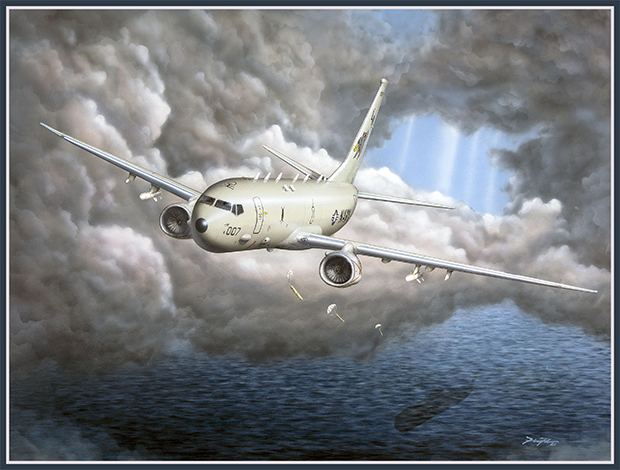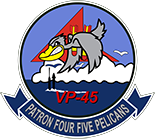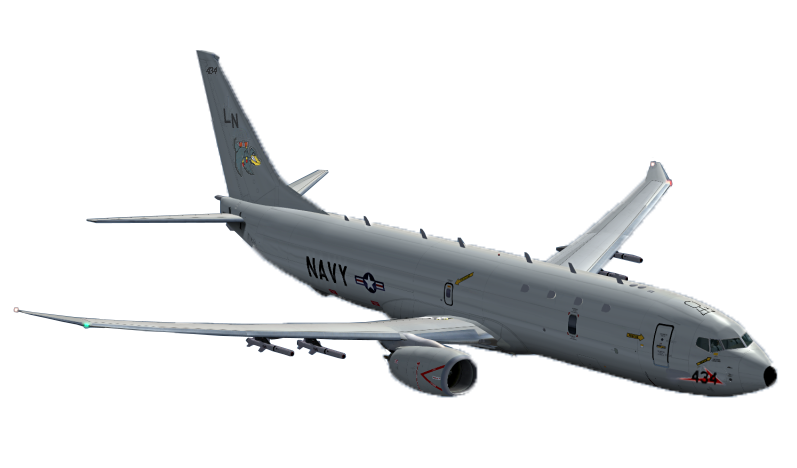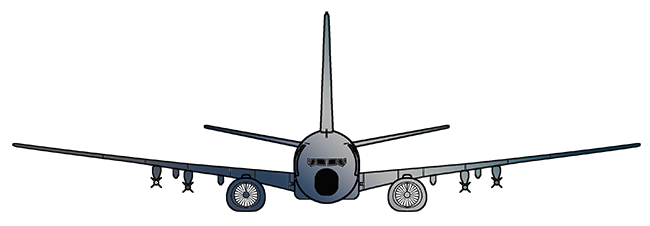













"God of The Sea" - An Original Painting by Don Feight

In June of 2013, after returning from a demanding, but very successful deployment to WestPac/Kadena, Japan, the squadron gave up their venerable P-3 Orion aircraft and commenced training with VP-30 to transition to the new P-8 Poseidon.
The Pelicans of VP-45 began their transition from the P-3C Orion to the P-8A Poseidon in July of 2013. On January 30, 2014 the Pelicans successfully completed their Conventional Weapons Training Proficiency Inspection (CWTPI). Inspectors from Commander, Patrol and Reconnaissance Wing (CPRW) -11 Weapons School judged the proficiency of both aviation electronics technicians (AT) and aviation ordnancemen (AO) through the process of wire-checking, uploading and downloading ordnance, such as torpedoes and chaff, on the P-8A aircraft.2015 P-8A
VP-45 obtained “Safe for Flight” status following an inspection on Feb. 27 – officially completing their transition to the P-8A Poseidon. In doing so, VP-45 became the Navy’s third operational P-8A squadron, following VP-16 and VP-5.
Before they could officially complete their transition to becoming an active duty squadron again, the Pelicans had to run the gauntlet of "Safe for Flight," a grueling weeklong inspection by Commander, Patrol and Reconnaissance Wing-11. The inspectors checked everything from emergency drills to NATOPS jackets to make sure that VP-45 was up to fleet standards and could perform these drills safely.
This was followed by an intensive year-long Inter-Deployment Readiness Cycle to prepare for their inaugural deployment with the new aircraft which included joint and multinational exercises designed to enhance interoperability between the U.S. and its allies. As part of the FRTP, VP-45, sent aircrews and maintainers all over the globe, including Estonia, Iceland, Hawaii, Guam, Bermuda, England, Peru and Chile supporting exercises such as BALTOPS, RIMPAC, Valiant Shield, Joint Warrior, SIFOREX and Teamwork South.
The squadron began its 2015 seven-month deployment to the U.S. 7th Fleet area of responsibility (AOR) when the first of six P-8A Poseidon aircraft departed from NAS Jacksonville on January 27. VP-45 relieved the “Mad Foxes” of VP-5 at Kadena Air Base in Okinawa, Japan on Feb. 10 assuming maritime patrol and reconnaissance efforts in support of national interests in the 7th Fleet AOR
 The Pelicans of VP-45 completed the first detachment of their deployment to Clark Air Base, Republic of the Philippines. From Feb. 1 - 21; the Pelicans mission supported 7th Fleet objectives around the clock to strengthen maritime partnerships while conducting routine patrols across the 7th Fleet area of responsibility. The Pelicans later participated in the Australian International Airshow, March 18, 2015, which is a representation of more than 27 countries and 500 aircraft. VP-45 participated with a P-8A Poseidon aircraft flown by Combat Aircrew (CAC) 12.
The Pelicans of VP-45 completed the first detachment of their deployment to Clark Air Base, Republic of the Philippines. From Feb. 1 - 21; the Pelicans mission supported 7th Fleet objectives around the clock to strengthen maritime partnerships while conducting routine patrols across the 7th Fleet area of responsibility. The Pelicans later participated in the Australian International Airshow, March 18, 2015, which is a representation of more than 27 countries and 500 aircraft. VP-45 participated with a P-8A Poseidon aircraft flown by Combat Aircrew (CAC) 12.
On May 14, Cmdr. John Weidner relieved Cmdr. T. J. Grady as commanding officer of VP-45 at a change of command ceremony held at Kadena Air Base, Okinawa, Japan, that featured an address from guest speaker Capt. Sean Liedman, commander of Patrol and Reconnaissance Wing (CPRW) 11.
CNN’s Chief National Security Correspondent, Jim Sciutto, joined Capt. Mike Parker, commander Task Force Seven Two (CTF-72), and Combat Air Crew 11 of VP-45 on a mission in the South China Sea May 20, to report on China's rapid land reclamation activities in the contested Spratly Islands. The Pentagon’s decision to declassify aspects of the routine surveillance flight followed U.S. Secretary of State John Kerry’s visit to Beijing amid escalating tensions between the United States and China on the issue. Territorial disputes with five other nations in the region conflict with China’s claims — Taiwan, Malaysia, Brunei, Vietnam, and the Philippines all claim sovereignty over various parts of the Paracel and Spratly Islands.
On July 2015, the new commander of the US Pacific Fleet, Admiral Scott Swift, joined a surveillance mission over the West Philippine Sea on Saturday as part of his four-day visit to the country. As part of his visit to the Philippines, Adm. Scott Swift took part in a seven-hour maritime surveillance mission to witness firsthand the full range of the Poseidon’s capabilities.
The squadron returned from deployment in September 2015, after racking up 665 sorties totaling 1,644 operational flight hours, including 219 hours of submerged contact in support of commander, Task Force Seven Four. VP-45 executed 10 detachments to 10 nations spanning the Pacific Command area to include the South China Sea, the Strait of Malacca in Malaysia, Thailand, Indonesia, and the Philippines.
Sailors from Patrol Squadron 45 participated in the Dubai Air Show (DAS 15) from 8-12 Nov. 2015 to strengthen military-to-military relationships and reinforce ties with allies of the region. DAS is a biennial event held in Dubai, United Arab Emirates beginning in 1986. It has now become one of the biggest aerospace events in the Middle East, Asia and Africa. The Pelican’s P8-A Poseidon was just one of over 1,100 exhibitors from 61 countries, over 66,000 trade visitors, a $37.2 billion order book and 150 aircraft.

The Pelicans of Patrol Squadron 45 conducted the first burial-at-sea in a P-8A aircraft. James Lincoln "Linc" Sparks Sr., a deceased former naval flight officer and member of VP-45 was laid to rest on January 8, 2016. The burial-at-sea ceremony is an honored tradition dating back to World War II. It’s available for active duty members of the uniformed services, retirees and honorably discharged veterans, Military Sealift Command U.S. civilian marine personnel and their family members. It helps to recognize service members and the sacrifices they have made.
Throughout 2016, the VP-45 Pelicans showed a consistent dedication to operational excellence and performance while maintaining above average qualification and maintenance standards. The Pelicans took part in two major exercises while on home cycle during June and July of 2016: SIFOREX Exercise and RIMPAC Exercise. Silent Force Exercise is an advanced anti-submarine warfare bilateral exercise held in Peru to provide training against diesel-electric powered submarines. RIMPAC is the world's largest international maritime exercise with 27 nations and over 25,000 people participating. These exercises proved a vital launching point for the pre-deployment evaluations and work-ups which would dominate the first half of 2016 for the squadron.
In August 2016, the Pelicans of VP-45 began their first SIXTH Fleet deployment in the P-8A to Sigonella, Italy. As soon as the squadron settled in after turning over with Patrol Squadron Four, the Pelicans quickly took to the skies. During the eight month deployment, the Pelicans participated in a wide variety of missions to include search and rescue operations, anti-submarine warfare (ASW), surveillance and Strike Coordination and Reporting. The squadron participated in Operations Atlantic Resolve, Sea Guardian, Snap Hook, Cold Anvil, Pick Axe and Crow Bar. While conducting these operations, the Pelicans flew 591 sorties and logged 3,782.9 flight hours.
In addition to their regular missions, the Pelicans had the opportunity to participate in multiple exercises from various locations. In September, VP-45 crews flew ASW missions in support of Exercise Northern Coast from Denmark and Romania and participated in Airshows in Naples and Malta. In October, crews flew ASW missions in support of Exercise Cable Car from Scotland and participated in the airshow in Coningsby, England. VP-45’s participation in these airshows made Naval Aviation history as this was the first ever presence of the “Mighty” P-8 Poseidon within the SIXTH Fleet Area of Operations. Crews and support personnel also participated in the Mavi Balina exercise in November. These exercises gave the Pelicans several opportunities to work with foreign militaries and demonstrate the immense capabilities of the U.S. Maritime Patrol and Reconnaissance community.
Throughout 2016-2017, the Pelicans also demonstrated their commitment to professional development and service. Despite the challenges of their deployment, the squadron continued to excel. 62 Navy and Marine Corps Achievement Medals, 29 Flag Letters of Commendation, 12 Safety Pros, 9 Navy Commendation Medals, 4 Military Outstanding Volunteer Service Medals, 3 Meritorious Service Medals and 23 Enlisted Aviation Warfare Specialist Wings were awarded to our Sailors for their exceptional service.
The Pelicans were deployed from October 2019 through May 2020 to the 7th Fleet Area of Responsibility (AOR) and assumed command of Task Group 72.2 (CTG-72.2) out of Kadena Air Base, Japan and a permanent detachment to Clark Air Base, Philippines. Along with conducting Maritime Intelligence, Surveillance, Reconnaissance (ISR), Theater Security Cooperation (TSC), and Anti-Submarine Warfare (ASW) missions. Though the COVID-19 pandemic certainly changed the deployment, the precise mission execution of the team was never hampered.
VP-45 Maintainers execute over 13,000 Pelican-Hours, ensure every mission succeeded. Led by dedicated leadership, the team has been well tuned – As one officer was overheard upon arrival to Kadena that if “what we’re doing everyday cannot be captured in the lines of the Commands Operational Excellence Principles, then we’re off course, and as each of us are leaders, we must right the ship.” While deployed to Kadena AB and three ASW operating detachments, the Pelicans expended 3,687 sonobuoys, 11 EMATTS, 6 Smokes and 5 SUS. During a lifesaving mission, they also expended a UNIT PAC II SAR KIT. The Ordnance Work Center met all Commanders Guidance as to war fighting readiness with six live loads, with zero mishaps. The VP-45 AOs worked alongside VP-10 to ensure their squadron also had adequate time to train and perform loads.
The Pelicans, operated in the restrictive COVID-19 environment from January 2020 and were “all hands were on deck” to support the critical life-preserving protocols. The squadron has effectively been operating in a bubble since the outbreak, conducting daily screenings of all-hands.
History last updated 2/18/21
Send questions, comments or suggestions regarding this website to: vp45association.org
Copyright © 2005 PATRON FOUR FIVE ASSOCIATION